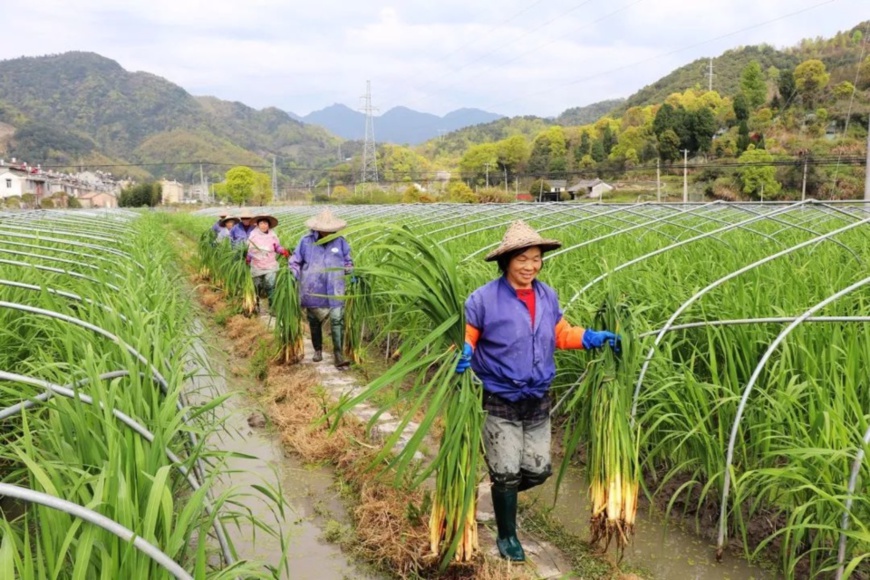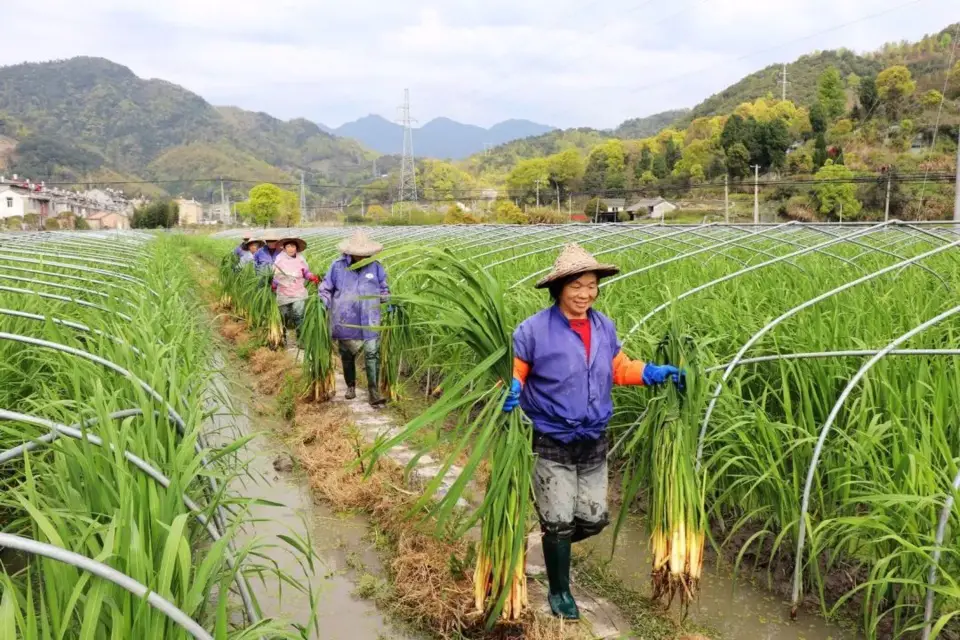By Gu Chun, Zhang Shuaizhen, People’s Daily

Photo shows a wild rice shoot planting base in Huangyan district, Taizhou city, east China’s Zhejiang province. (Photo/Official WeChat account of the publicity department of the Communist Party of China committee of Huangyan district)
As digital technologies have been applied in the production and people’s daily life in rural areas of east China’s Zhejiang province, local farmers are able to keep track of the soil moisture status and fertilizer concentration via their mobile phones, trace the whole process of agricultural production by scanning QR codes, and participate in social governance through intelligent systems.
At the beginning of this year, the provincial government of Zhejiang issued a plan for the construction of “digital villages”, providing a blueprint for digital governance in rural areas.
Tao Kaiquan, an experienced farmer born in the 1960s in Huangyan district, Taizhou city of Zhejiang, often checks on his mobile phone the condition of his citrus greenhouses.
According to Tao, also general manager of an ecological agriculture company, he has downloaded to his mobile phone an app that is connected to 20 sensors in his citrus greenhouses. By showing in real time the temperature, humidity, light, and other indicators reflecting the environmental conditions of the greenhouses, the app allows him to realize efficient production management.
After the app gave a warning that the soil moisture content fell below 50 percent, Tao immediately informed a worker in his greenhouse, who then turned on a switch and set in motion nearly 100 irrigation drippers hanging in the greenhouses.
“We rely on data in farming, not experience anymore,” Tao said, who recalled that farmers like him had to judge according to experience how much fertilizer and water to add and how to adjust the temperature, humidity and light appropriately.
Farm work has become a lot easier with the intelligent water and fertilizer integrated drip irrigation system, sensors, and mobile app, noted Tao, who has been quite familiar with the terms of digital agriculture. The drippers, which are fixed 40 centimeters away from each other, can transport the same amount of precisely proportioned fertilizer solution directly to the roots of citrus trees, he said.
The government has provided subsidies to encourage leading agricultural companies to embrace digital and intelligent transformation. The effort has helped standardize agricultural production and make his citrus fruits warmly received in the market and more profitable, according to Tao.
After harvesting wild rice shoots, Jiang Liangzhen, manager of a wild rice shoot cooperative in Guan’ao village, Beiyang township, Huangyan district, quickly input information about the harvest into an app on her mobile phone.
According to Jiang, she has recorded all the watering, ploughing, fertilization and other agricultural activities during the growth of wild rice shoots, from sowing to harvesting, through the app.
As Jiang inputting figures into her mobile phone, workers of the cooperative packaged up wild rice shoots, stuck a QR code on each package box, and loaded the boxes onto trucks.
“The QR code is like the ID card of our wild rice shoots as well as their pass to the market,” Jiang said, explaining that by scanning the QR code, people can get information about the planting environment, harvest date, and quality testing report, and other information about the wild rice shoots.
Safety of farm produce was the first area Huangyan district included into digital regulation by enabling real-time data updating for tracing the whole process of production. The district has built a database for practitioners in agricultural production and operation, requiring agricultural producers above designated size to label the packages of their products with quality certificates, said an official with the agriculture and rural affairs bureau of Huangyan district.
As more and more practitioners like Jiang use the app, they can record information about crops on their mobile phones in time and the app will automatically integrate data and images uploaded by them.
In an effort to make sure the whole production process is traceable, Huangyan district has intensified spot checks of agricultural products. “Approximately 1,000 batches are sampled every year to test the residue level of 68 pesticides, and the results of the sample testing will also be uploaded to the app,” said Yu Jianghui, an official with the agriculture and rural affairs bureau of Huangyan district, who believes it important for farm produce to be gradually labeled with quality certificates like manufactured goods.
At the beginning of this year, the provincial government of Zhejiang issued a plan for the construction of “digital villages”, providing a blueprint for digital governance in rural areas.
Tao Kaiquan, an experienced farmer born in the 1960s in Huangyan district, Taizhou city of Zhejiang, often checks on his mobile phone the condition of his citrus greenhouses.
According to Tao, also general manager of an ecological agriculture company, he has downloaded to his mobile phone an app that is connected to 20 sensors in his citrus greenhouses. By showing in real time the temperature, humidity, light, and other indicators reflecting the environmental conditions of the greenhouses, the app allows him to realize efficient production management.
After the app gave a warning that the soil moisture content fell below 50 percent, Tao immediately informed a worker in his greenhouse, who then turned on a switch and set in motion nearly 100 irrigation drippers hanging in the greenhouses.
“We rely on data in farming, not experience anymore,” Tao said, who recalled that farmers like him had to judge according to experience how much fertilizer and water to add and how to adjust the temperature, humidity and light appropriately.
Farm work has become a lot easier with the intelligent water and fertilizer integrated drip irrigation system, sensors, and mobile app, noted Tao, who has been quite familiar with the terms of digital agriculture. The drippers, which are fixed 40 centimeters away from each other, can transport the same amount of precisely proportioned fertilizer solution directly to the roots of citrus trees, he said.
The government has provided subsidies to encourage leading agricultural companies to embrace digital and intelligent transformation. The effort has helped standardize agricultural production and make his citrus fruits warmly received in the market and more profitable, according to Tao.
After harvesting wild rice shoots, Jiang Liangzhen, manager of a wild rice shoot cooperative in Guan’ao village, Beiyang township, Huangyan district, quickly input information about the harvest into an app on her mobile phone.
According to Jiang, she has recorded all the watering, ploughing, fertilization and other agricultural activities during the growth of wild rice shoots, from sowing to harvesting, through the app.
As Jiang inputting figures into her mobile phone, workers of the cooperative packaged up wild rice shoots, stuck a QR code on each package box, and loaded the boxes onto trucks.
“The QR code is like the ID card of our wild rice shoots as well as their pass to the market,” Jiang said, explaining that by scanning the QR code, people can get information about the planting environment, harvest date, and quality testing report, and other information about the wild rice shoots.
Safety of farm produce was the first area Huangyan district included into digital regulation by enabling real-time data updating for tracing the whole process of production. The district has built a database for practitioners in agricultural production and operation, requiring agricultural producers above designated size to label the packages of their products with quality certificates, said an official with the agriculture and rural affairs bureau of Huangyan district.
As more and more practitioners like Jiang use the app, they can record information about crops on their mobile phones in time and the app will automatically integrate data and images uploaded by them.
In an effort to make sure the whole production process is traceable, Huangyan district has intensified spot checks of agricultural products. “Approximately 1,000 batches are sampled every year to test the residue level of 68 pesticides, and the results of the sample testing will also be uploaded to the app,” said Yu Jianghui, an official with the agriculture and rural affairs bureau of Huangyan district, who believes it important for farm produce to be gradually labeled with quality certificates like manufactured goods.
 Menu
Menu
 ‘Digital village’ makes agriculture smarter in east China’s Zhejiang
‘Digital village’ makes agriculture smarter in east China’s Zhejiang
















